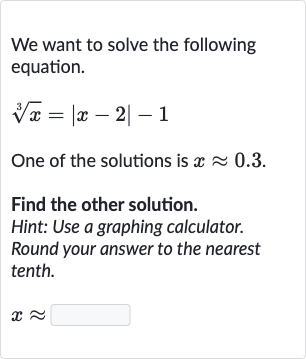Full solution
Q. We want to solve the following equation.One of the solutions is .Find the other solution.Hint: Use a graphing calculator.Round your answer to the nearest tenth.
- Understanding the Equation: First, let's understand the equation . This equation involves a cube root function and an absolute value function. To find the other solution, we can use a graphing calculator to plot both sides of the equation as separate functions and look for their intersection points. One of the solutions is given as approximately . We need to find the other solution.
- Plotting the Cube Root Function: Using a graphing calculator, plot the function which is the cube root of . This function will be a curve that passes through the origin and increases as increases.
- Plotting the Absolute Value Function: Next, plot the function on the same graph. This function will have a V-shape with a vertex at because the absolute value creates two linear pieces, one with a positive slope and one with a negative slope.
- Finding Intersection Points: Look for the intersection points of the two functions on the graph. We already know one of the solutions is approximately . The other intersection point will be the other solution we are looking for.
- Identifying the Second Solution: Identify the -coordinate of the second intersection point using the graphing calculator's intersection feature or by visually inspecting the graph. Let's assume the graphing calculator gives us an approximate value for the second solution.
- Rounding the Second Solution: Round the value of the second solution to the nearest tenth as instructed. Let's say the graphing calculator gives us an approximate value of for the second solution.

